

|
| DEUTSCHLAND | GERMANY |
| Bundesland: Niedersachsen | Lower Saxony |
| Stadt: Wilhelmshaven |
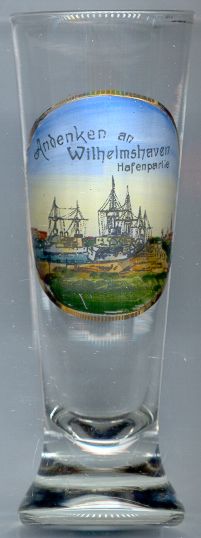
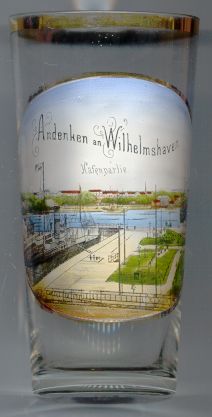 Wilhelmshaven is situated at the northwestern shore of the Jadebusen, the bay of the river Jade.
During the 14th century it was a stronghold of pirates. Their castle Sibetsburg (in today's quarter of Siebethsburg),
which they had built in 1383, was destroyed in 1433 by the Hanseatic league of trading towns.
The modern history of Wilhelmshaven only starts in 1848 when the Prussian army began to set up an own navy.
In the Jade Contract of 1853 the Grand Duchy of Oldenburg ceded an area of 313 hectares to Prussia for the purpose of building a North Sea port.
The port was opened in 1869 by King Wilhelm I of Prussia (later German Emperor). At the same time the village that had
developed during the construction of the port was named Wilhelmshaven in honour of the King. In 1873 Wilhelmshaven received the rights
of a town (although it retained the status of a rural community until 1919). Wilhelmshaven and the neighbouring town of Rüstringen were merged in 1937.
During World War II Wilhelmshaven suffered severe damages. After the war the industrial development replaced the previous military
importance of the town. Today Wilhelmshaven is Germany's second-largest port after Hamburg and before
Bremen.
Wilhelmshaven is situated at the northwestern shore of the Jadebusen, the bay of the river Jade.
During the 14th century it was a stronghold of pirates. Their castle Sibetsburg (in today's quarter of Siebethsburg),
which they had built in 1383, was destroyed in 1433 by the Hanseatic league of trading towns.
The modern history of Wilhelmshaven only starts in 1848 when the Prussian army began to set up an own navy.
In the Jade Contract of 1853 the Grand Duchy of Oldenburg ceded an area of 313 hectares to Prussia for the purpose of building a North Sea port.
The port was opened in 1869 by King Wilhelm I of Prussia (later German Emperor). At the same time the village that had
developed during the construction of the port was named Wilhelmshaven in honour of the King. In 1873 Wilhelmshaven received the rights
of a town (although it retained the status of a rural community until 1919). Wilhelmshaven and the neighbouring town of Rüstringen were merged in 1937.
During World War II Wilhelmshaven suffered severe damages. After the war the industrial development replaced the previous military
importance of the town. Today Wilhelmshaven is Germany's second-largest port after Hamburg and before
Bremen.
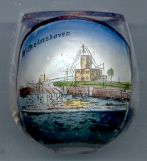
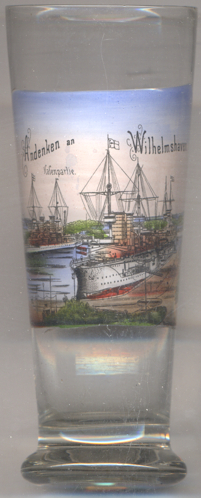
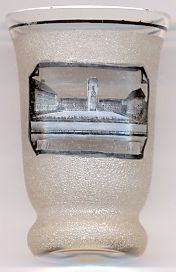
The  Town Hall in Rüstringen [left] was built in 1928–1929 by
Fritz Höger. The impressive clinker construction became a landmark of Wilhelmshaven and often is lovingly called
"the castle at the sea". After the merging of Wilhelmshaven and Rüstringen in 1937 it became the town hall of the
unified city. The impressive tower (49 metres high) was also used as a water reservoir for the city. In 1944 it was
hit by bombs and iburnt out; the east wing was almost completely destroyed. The reconstruction works that began after
the World War II lasted until 1953.
Town Hall in Rüstringen [left] was built in 1928–1929 by
Fritz Höger. The impressive clinker construction became a landmark of Wilhelmshaven and often is lovingly called
"the castle at the sea". After the merging of Wilhelmshaven and Rüstringen in 1937 it became the town hall of the
unified city. The impressive tower (49 metres high) was also used as a water reservoir for the city. In 1944 it was
hit by bombs and iburnt out; the east wing was almost completely destroyed. The reconstruction works that began after
the World War II lasted until 1953.
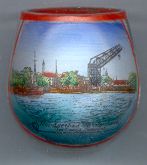
The crane  Langer Heinrich [left]
once was a beloved landmark of Wilhelmshaven. The crane was built in 1913–1915 and replaced a previous crane (which also had been nicknamed
"Langer Heinrich"). Until 1925 it was the world's largest swimming crane (height 51–81.4–96 m, displacement 3,900 tons).
After World War I the Treaty of Paris (Versailles) ordered the crane to be
delivered but eventually it remained in Wilhelmshaven because the sea transport seemed to difficult. During World War II the
crane was tugged on the river Weser to Bremen where
it was used to retrieve shipwrecks. After 1945 it was used at Bremen by the US Navy. In 1950 it was moved to Bremerhaven
where it was chartered by the Federal Republic of Germany in 1958. In 1981 it was auctioned off by the US authorities. The Bremerhaven Motorenwerke
purchased it soon after that and restored it with the financial help of the city of Bremerhaven. In 1985 it was sold to the harbour of
St. Antiocco on Sardinia, now named "Maestrale". Years later it was sold again to the harbour of Genova in Italy where it is still in service today,
almost 90 years after its construction.
Langer Heinrich [left]
once was a beloved landmark of Wilhelmshaven. The crane was built in 1913–1915 and replaced a previous crane (which also had been nicknamed
"Langer Heinrich"). Until 1925 it was the world's largest swimming crane (height 51–81.4–96 m, displacement 3,900 tons).
After World War I the Treaty of Paris (Versailles) ordered the crane to be
delivered but eventually it remained in Wilhelmshaven because the sea transport seemed to difficult. During World War II the
crane was tugged on the river Weser to Bremen where
it was used to retrieve shipwrecks. After 1945 it was used at Bremen by the US Navy. In 1950 it was moved to Bremerhaven
where it was chartered by the Federal Republic of Germany in 1958. In 1981 it was auctioned off by the US authorities. The Bremerhaven Motorenwerke
purchased it soon after that and restored it with the financial help of the city of Bremerhaven. In 1985 it was sold to the harbour of
St. Antiocco on Sardinia, now named "Maestrale". Years later it was sold again to the harbour of Genova in Italy where it is still in service today,
almost 90 years after its construction.
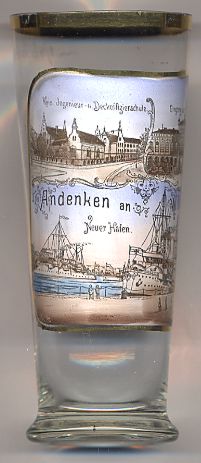
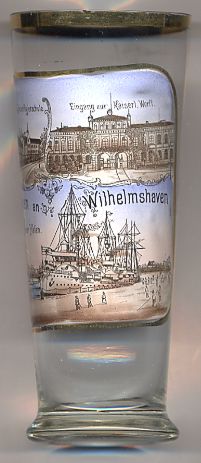
Glass no. 2508 [left and right] shows views from the  New
New
[top left]:  Kaiserliche Ingenieurs- und Deckoffiziersschule (Imperial School for Engineers and Officers of the Deck).
Kaiserliche Ingenieurs- und Deckoffiziersschule (Imperial School for Engineers and Officers of the Deck).
[top right]:  Entrance to the Imperial Dockyards.
Entrance to the Imperial Dockyards.

The  Neue Signalstation (New Signal Station) [near left, no. 2666]
was built in 1866 and is located on the east side of the former first harbour entrance. The building is now owned by the
Water and Shipping Office. The signal station is one of the last examples of objects of this type, which were
built for the optical communication between ships.
Neue Signalstation (New Signal Station) [near left, no. 2666]
was built in 1866 and is located on the east side of the former first harbour entrance. The building is now owned by the
Water and Shipping Office. The signal station is one of the last examples of objects of this type, which were
built for the optical communication between ships.
[http://www.karwath24.de/wilhelmshaven_abisz_S.html]
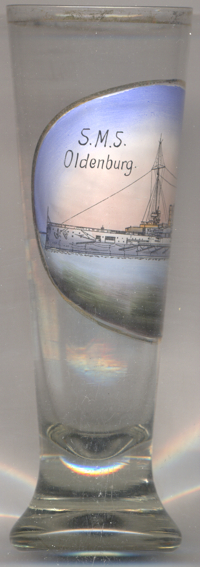
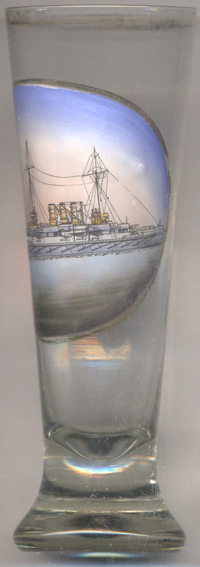
 S.M.S. Oldenburg [left, no. 3606] was the fourth vessel of
the Helgoland class of battleships of the Imperial German Navy. Oldenburg's keel was laid
in October 1908 at the Schichau-Werke dockyard in Danzig (today Gdańsk, Poland). Named for
the Grand Duchy of Oldenburg, she was launched on 30 September 1909 and was commissioned into
the fleet on 1 May 1912. Oldenburg was assigned to the 1st Battle Squadron of the High Seas Fleet (the
primary base of which was Wihelmshaven) for the majority of her career, including World War I. Along with her three
sister ships, Helgoland, Ostfriesland, and Thüringen, Oldenburg participated in all of the
major fleet operations of World War I in the North Sea against the British Grand Fleet. The ship also saw action in the
Baltic Sea against the Imperial Russian Navy. She was present during the unsuccessful first incursion into the Gulf of
Rīga in August 1915, though she saw no combat during the operation. After the German collapse in November 1918, most
of the High Seas Fleet was interned and then scuttled in Scapa Flow during the peace negotiations. The four Helgoland-class
ships were allowed to remain in Germany but eventually ceded to the victorious Allied powers as war reparations;
Oldenburg was given to Japan, which sold the vessel to a British ship-breaking firm in 1920. She was broken up for
scrap in Dordrecht in 1921.
S.M.S. Oldenburg [left, no. 3606] was the fourth vessel of
the Helgoland class of battleships of the Imperial German Navy. Oldenburg's keel was laid
in October 1908 at the Schichau-Werke dockyard in Danzig (today Gdańsk, Poland). Named for
the Grand Duchy of Oldenburg, she was launched on 30 September 1909 and was commissioned into
the fleet on 1 May 1912. Oldenburg was assigned to the 1st Battle Squadron of the High Seas Fleet (the
primary base of which was Wihelmshaven) for the majority of her career, including World War I. Along with her three
sister ships, Helgoland, Ostfriesland, and Thüringen, Oldenburg participated in all of the
major fleet operations of World War I in the North Sea against the British Grand Fleet. The ship also saw action in the
Baltic Sea against the Imperial Russian Navy. She was present during the unsuccessful first incursion into the Gulf of
Rīga in August 1915, though she saw no combat during the operation. After the German collapse in November 1918, most
of the High Seas Fleet was interned and then scuttled in Scapa Flow during the peace negotiations. The four Helgoland-class
ships were allowed to remain in Germany but eventually ceded to the victorious Allied powers as war reparations;
Oldenburg was given to Japan, which sold the vessel to a British ship-breaking firm in 1920. She was broken up for
scrap in Dordrecht in 1921.
[https://en.wikipedia.org/wiki/SMS_Oldenburg, https://en.wikipedia.org/wiki/High_Seas_Fleet]
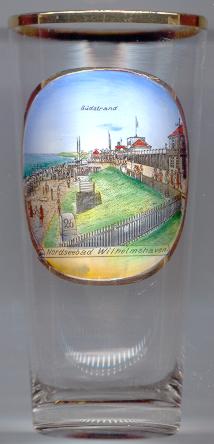
Glass no. 834 [left] shows a view of the seaside spa  Nordstrand ('North Beach').
Nordstrand ('North Beach').
![[scale]](lineal.jpg)